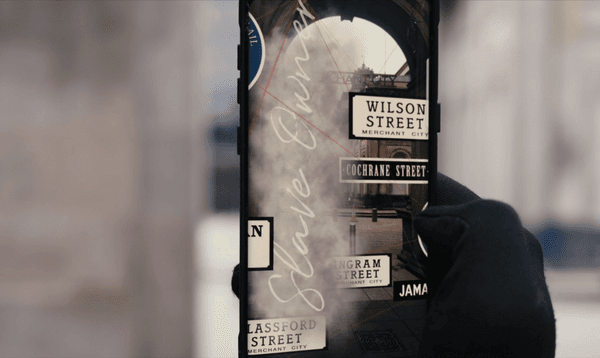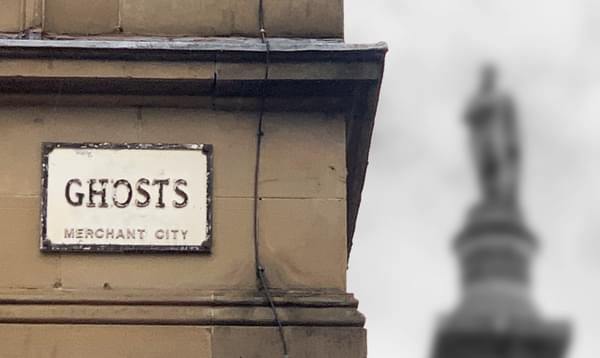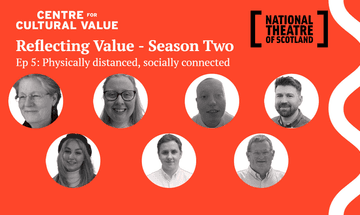News Story
Peggy Brunache in Merchant City
Credit: Kirsty AndersonSlavery walking tours and experiences, to highlight a city’s historical links to slavery, are growing in popularity in the UK as a powerful public voice that insists that Atlantic slavery be recognised and incorporated into British history. Glasgow has spent years shaping and refining its own slavery walking tours, commissioned by various organisations including the local council and racial equality charities and performed by leading scholars on Scottish history and Atlantic slavery. This month, award winning Glasgow-based director, actor, and writer Adura Onashile revisits Glasgow’s history through a new immersive app featuring the voice of an enslaved Black male servant, resisting his enslavement, and taking participants on a (re)assessment of Glasgow’s built environment. Along the way, we become acquainted with other enslaved Africans and glean some heart-breaking but ultimately heroic, stories of resistance, love, and resilience borne out of Glasgow’s historical links to slavery.
In the first decade of the 21st century, as Britain prepared to celebrate the bicentennial anniversary of the slave trade abolition, Scotland began to engage with its involvement in slavery, beyond the abolitionist movement. Scottish historians, whose work centred on Glasgow’s tobacco lords and sugar barons cited historical amnesia as the reason for ignoring the experiences of enslaved Africans, that made those men wealthy. In actuality, this was a conscious historical disassociation that began with the privileging of Scottish abolitionists over the horrifically brutal exploitation and violence that made Glasgow prosper. This doubling trauma (the original acts of slavery then the ‘forgetting’ or disassociation) is now being challenged more openly, both academically and through innovative and creative projects.
One of the first messages participants on the Ghosts app experience receive is through the strong male voice of a nameless enslaved person:
I am a boy. I am this city. I am my master’s house. Built with my blood, my sweat, my dying. I am Glasgow. Proud. Puffed. Primped. I am your workers, your baillies, your lord provosts and your tobacco merchants. I am the boy you took by the hand.
This radical conflation of the nameless and enslaved, rendered almost invisible has the audacity to equate his presence and contribution with that of Glasgow’s most beloved benefactors. Hard to believe? Our guide, an escaped fugitive, asks us to join him and to see his Glasgow, from his enslaved perspective. Through the app installed on your mobile, the enslaved whispers to you, beckoning you to walk with him; run with him.
Onashile’s digital slavery site specific app, produced by the National Theatre of Scotland, is part art installation - part history tour. While most Scots are aware to some degree of Scotland’s involvement in the transatlantic slave trade and Atlantic slavery, few know that tens of thousands of enslaved people lived and worked in Britain despite the illegality of slavery on British soil.
Ghosts' inspiration is derived from 18th century advertisements posted in British newspapers calling for the capture and return of enslaved fugitives who had dared to resist their bound servitude for self-emancipation and a chance at an independent life. Since the 17th century, these runaway advertisements* were common in newspapers throughout Britain, the colonial Caribbean islands, and North America. These adverts expand our understanding of slavery to include a glimpse of enslaved life and resistance away from tropical plantations but in the streets of Merchant City. Instead of the traditional ‘what happened here on this date’, participants absorb Glasgow’s history through personalised prose and poetry. Within a few minutes of the app, some of Onashile’s goals start to materialise: the Black bodies forced to labour for Scottish slaveholders on tobacco and sugar estates in the Caribbean and North American colonies may have been forgotten by the Scottish masses but they too, were just as much part of Glasgow as the celebrated merchants Glassfords, Buchanans, Dunlops, Speirs, and Ingrams, and many more. Whether Glaswegians know it or not, Black people were an integral part of establishing Glasgow as the Second City of the Empire.
Reuben Joseph (voice of the young man) in Merchant City
Credit: Kirsty AndersonMore importantly, Onashile’s digital app experience reinforces the truth: the past is still with us. You see it every time you walk down Jamaica St, Virginia St, Kingston Bridge. You see the iconic front facing of the Gallery of Modern Art (GOMA) with the Duke of Wellington, his trusty orange traffic road cone, and faithful steed but there is no monument to the enslaved people responsible for William Cunninghame’s wealth. Glasgow’s mercantile history has a Black and bloody heritage. These Africans were also bound to some of the Empire’s greatest Enlightenment figures such as Lord Monboddo and Samuel Johnson; heralded for their intellectual and scientific advancements, whilst their enslaved domestic servants tended to the slaveholder’s every need.
Moreover, these advertisements provide provocative clues to the hidden lives of Black, South Asian, and Native American women, men, girls, and boys, struggling under an institution of racialised terror and enforced labour while Britain wrote and celebrated patriotic songs of empire expansionism and hailed ‘Britons never will be slaves!’ Enslaved servants such as Francis Barber, Mr. Gory, Frederick, Caesar, and the thousands more who were forced to work and live in Glasgow and all across Scotland or as gossamer bodies will no longer be rendered invisible.
Onashile’s augmented app is justly titled Ghosts. As Avery Gordon once wrote in Ghostly Matters: Haunting and Sociological Imagination (1997), the ghosts of history affect our social reality. They ‘are never innocent: the unhallowed dead of the modern project drag in the pathos of their loss and the violence of the force that made them, their sheets and chains.... Following ghosts is about making a contact that changes you and refashions the social relations in which you are located. It is about putting life back in where only a vague memory or a bare trace was visible to those who bothered to look. It is sometimes about ghost stories, stories that not only repair representational mistakes, but also strive to understand the conditions under which a memory was reproduced in the first place, toward a counter-memory of the future’. Merchant City has been haunted by Black ghosts for centuries. But now, they demand your attention and acknowledgement for their role in Glasgow’s mercantile past. They will be seen. They will be heard. We will remember.
*The collaborative efforts of scholars studying British advertisements on enslaved and indentured fugitives in Britain resulted in a user friendly database and is accessible to the public: https://www.runaways.gla.ac.uk/
Peggy Brunache is a Lecturer at University of Glasgow on the history of Atlantic slavery
Related events




